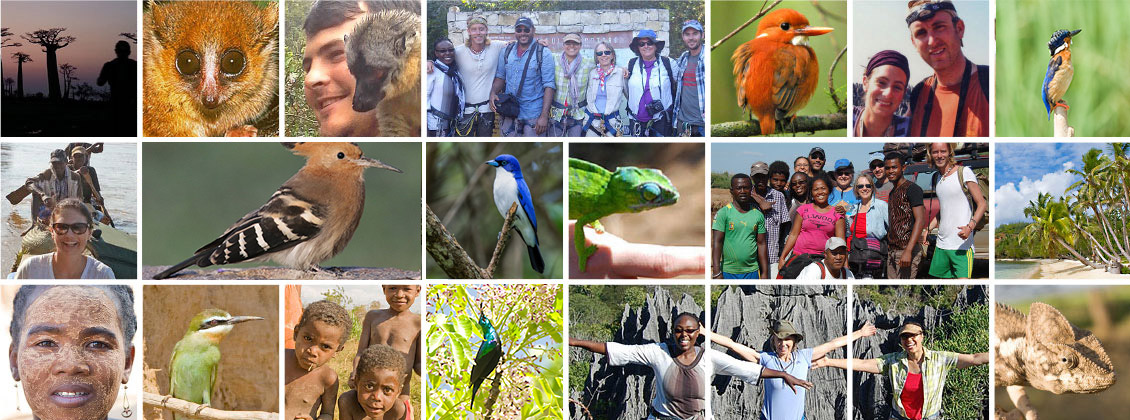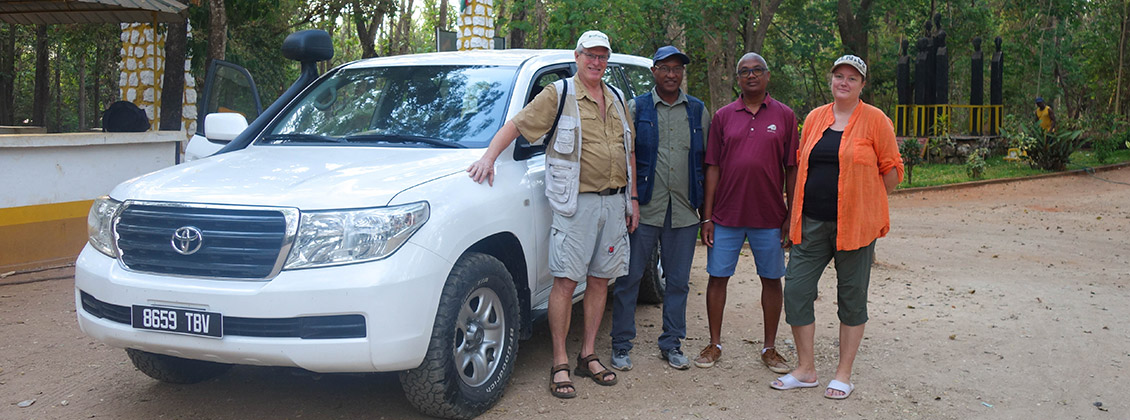Madagascar Bird Circuit
Madagascar has been celebrated for its extraordinary and rich biodiversity of bird species. Over two hundred species are recorded, of which most are very rare and endemic. Because of deforestation our bird population is threatened. Madagascar is now among the world’s highest priority regions for conservation effort. To assist in their conservation, we offer this birding circuit in collaboration with the ASITY Association, which includes Madagascar ornithologist. By opting for this circuit, you make your contribution to the preservation of the avifauna of Madagascar.
Madagascar – Bird Circuit
19 days / 18 nights
Antananarivo – Majunga – Ankarafantsika – Antsirabe – Ranomafana – Ranohira – Tulear – Anakao – Ifaty
Including: Car and driver, hotel, breakfast, entrances parks, speedboat, airline ticket, guide, fuel.
Price on request
Best time: September to November
Madagascar – Bird Circuit – day to day program
Day 1: Antananarivo – Majunga
Arrival at Tana Airport and welcome by our guide and ornithologist. Check in or make arrangements for the connecting flight to Majunga. Departure at the Majunga bay to Bombetoka to observe numerous species of sea birds including the Sacred Ibis. In the afternoon there is a canoe trip to spot some more birds. In the late afternoon we return to Majunga for diner and relaxing in the hotel.
Day 2: Ankarafantsika NP
An route to the Ankarafantsika National Park, one of the most beautiful parks on the Big Island, an ornithologists’ dream. In the afternoon we’ll make a relaxing canoe trip on Lake Ravelobe to observe water birds and the famous eagle sinner or Ankoay Madagascar. At the end of the day we return to the hotel in Ankarafantsika.
Checklist of Birds in Ankarafantsika:
Madagascar Buzzard, White-breasted Mesite, Coquerel’s Coua, Coua Crested, Broad-billed Roller, Mascarene Martin, Long-billed Tetraka, Rufous Vanga, Van Dam’s Vanga, Sickle-billed Vanga, Crested Drongo, Sakalava Weaver
Day 3: Ankarafantsika NP
This day is dedicated to the discovery of the dense deciduous forest of the park. We can observe several rare species such as the Van Dam’s Vanga Vanga, the Asity Schlegel or the eagle of Madagascar. We return to a Ankarafantsika for the night.
Day 4: Antananarivo
An early morning visit to the park, then off to Tana, across the great plains of Bongolava. We spend the night in Tana.
Day 5: Antananarivo
A morning visit to the private park of Tsarasaotra, a classified RAMSAR site (Wetlands of International Importance, especially as Waterfowl Habitat). This quiet oasis is a nesting place for many species of birds such as Squacco, the Black Heron or Whistling Duck. Then off to Andasibe where we will visit the private reserve of Peyreras. At the and of the day we return to Andasibe city center for the night.
Checklist of birds at the private Park of Tsarasaotra Alarobia:
White-faced ducks, Red-billed teal, teal Hottentol, Comb Duck, Fulvous ducks, pond heron Madagascar, Dimorphic Egret, Malagasy Kingfisher.
Day 6: Andasibe
This day is devoted to birding in the Mantadia National Park. This evergreen forest at medium altitude features 109 species of birds, including the Green Sunbird, Barn Madagascar (rare), Rail to nose pliers, the Hermet Vanga and several species of coua. This park is also the home of the diadem sifaka.
Checklist of Birds at Andasibe Mantadia and Maromizaha:
Madagascar little grebe, Dimorphic Egret, France’s Sparrowhank, Common Moorhen, Madagascar Kestrel, White-throated rail, Madagascar Fluff tail, Madagascar pratincole, Roch pigeon, Madagascar blue pigeon, Madagascar tuitte dove, Lesser Vasa Parrot, Madagascar Coucal, Madagascar lesser cuckoo, Red-breasted coua, Blue coua, Madagascar scops-owl, nightjar Madagascar, Alpine swifts, Africa palm swift, Broad-billed roller, kingfisher Madagascar, Madagascar pygmy kingfisher-, Madagascar bee-eater, Pitta-like ground roller, Mascarene martin, Madagascar bulbul, Long – billed Greenbul, Madagascar crested ibis, Velvet asity (Hard to see, but we’ll try).
We spend the night in a hotel in Andasibe.
Day 7: Andasibe
We visit of the Analamazaotra National Park. A tropical wet forest, home to the largest lemur: the Indri Indri. Easy to hear and observe. The park also contains other species of birds including the Asity and 5 species of Vanga.
Day 8: Antsirabe
On the road towards Antsirabe, we’ll travel trough a beautiful and versatile landscape of high plateaus and terraced rice fields.
Day 9: Ranomafana
After breakfast we will continue our journey towards Ranomafana National Park. Along the way we’ll visit a typically Zafimaniry Ambositra sculpture workshop.
Day 10-11: Ranomafana NP
Two days devoted to bird watching. The evergreen lowland forest Park is the home of 96 species of birds. Some of them are endemic, such as Asity the Mesite unicolor brown or Rollier land Crossley.
Checklist of Birds in Ranomafana:
Paradise Flycatcher, Ward’s flycatcher, Common Mynah, Hook-billed vanga, Tylas, Madagascar Brush warbler, Common Newtonia, Madagascar wood rail, Meller’s duck, Blue coua, Grey emutail, Yellow-browed Oxylabes, White-throated Oxylabes, Wedge – tailed jery , yellow – bellied sunbird – asity, Madagascar lesser cuckoo, Madagascar bulbul, Crested drongo, Pied crow, Rand’s Warbler, Pitta-like ground-roller, Cryptic warbler, Rufous-headed ground – roller, Short-legged ground-roller, Brown Mesite, Rufous vanga, Pollen’s vanga, Madagascar snipe, Grey – crowned Greenbul, Crossley’s babbler, nightjar Madagascar, Madagascar long-eared owl, Madagascar crested ibis.
Vohiparara: white eyes Madagascar / Madagascar lesser cuckoo.
Day 12: Ranohira
We leave very early for Ranohira. We pass Ambalavao to visit a papermaking workshop ‘Antaimoro’. Then we go to the forest community of Anjaha. Impressive granite rock formations embrace this small but beautiful park where we can observe ringtailed lemurs.
Day 13: Ranohira
Discovering beautiful Isalo National Park. We leave at a given moment to get back through the Massif du Merle. On the set of Horombe we can spot the Madagascar bush lark.
Day 14: Tulear
We go to the National Park Zombitse Vohibasia, which houses birds such as the endemic Appert’s tretraka Giant coua and Madagascar hoopoe. After a short hike in the park, we continue to Tulear and visit the Arboretum of Antsokay along the way.
Day 15: Tulear
We transfer to the white sandy beaches of Anakao, then off to Ambola. In the afternoon, a visit to the Tsimanampetsotse National Park. The site is an organic impotence especially for aquatic birds.
Day 16: Ambola
The day is dedicated to the discovery of Tsimanapetsotse National Park. Among the 112 species of birds identified, some of which are endemic to Madagascar, is the plover or Perigrime. But the main attraction, of course the colonies of flamingos, dwarf flamingos and grebes.
Day 17: Anakao
Transfer to Anakao, to spend the night.
Day 18: Tulear
Transfer to Tulear and connecting transport to Ifaty. We visit the dry forest of Baobabs of Reniala to observe the long-tailed Ground Roller or the Drongo Madagascar.
Cheklist of birds in Ifaty:
Madagascar Harrier-hawk, Nelicourvi weaver, weaver nelicourvi, Long-tailled ground-roller, Subdesrt Mesite, Madagascar buttonquail.
Day 19: Tana
A last morning visit to the dry forest. In the late afternoon we transfer to the airport for the flight from Tulear to Tana. Match for the international flight.
Checklist of birds in St. Augustine (Tulear):
Dimorphic Egret, Harlequin quail


